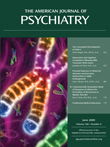Functional Disturbances Within Frontostriatal Circuits Across Multiple Childhood Psychopathologies
Abstract
Objective: Neuroimaging studies of healthy individuals inform us about the normative maturation of the frontostriatal circuits that subserve self-regulatory control processes. Findings from these studies can be used as a reference frame against which to compare the aberrant development of these processes in individuals across a wide range of childhood psychopathologies. Method: The authors reviewed extensive neuroimaging evidence for the presence of abnormalities in frontostriatal circuits in children and adults with Tourette’s syndrome and obsessive-compulsive disorder (OCD) as well as a more limited number of imaging studies of adolescents and adults with anorexia nervosa or bulimia nervosa that, together, implicate dysregulation of frontostriatal control systems in the pathogenesis of these eating disorders. Results: The presence of an impaired capacity for self-regulatory control that derives from abnormal development of frontostriatal circuits likely interacts in similar ways with normally occurring somatic sensations and motor urges, intrusive thoughts, sensations of hunger, and preoccupation with body shape and weight to contribute, respectively, to the development of the tics of Tourette’s syndrome, the obsessions of OCD, the binge eating behaviors of bulimia, and the self-starvation of anorexia. Conclusions: Analogous brain mechanisms in parallel frontostriatal circuits, or even in differing portions of the same frontostriatal circuit, may underlie the differing behavioral disturbances in these multiple disorders, although further research is needed to confirm this hypothesis.



